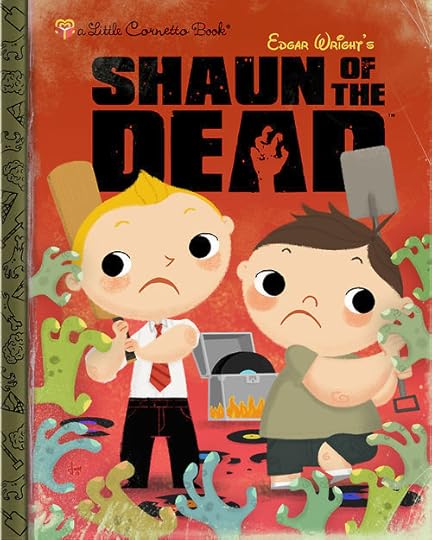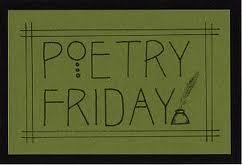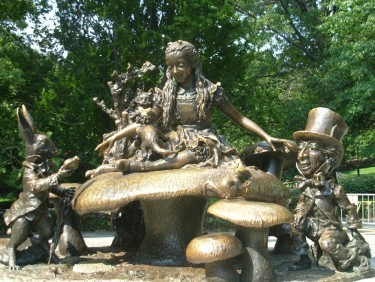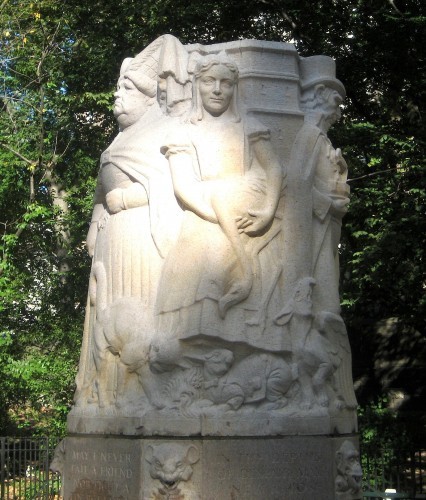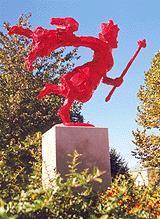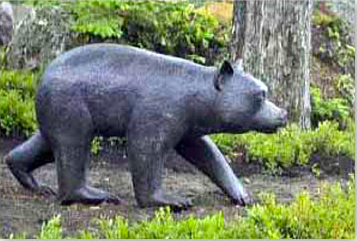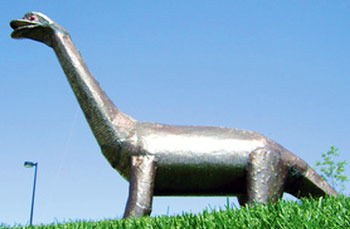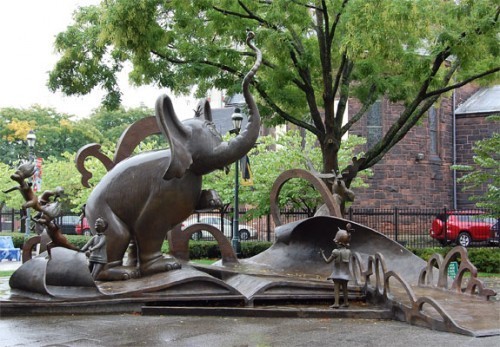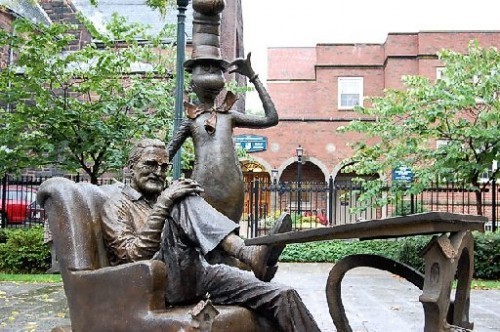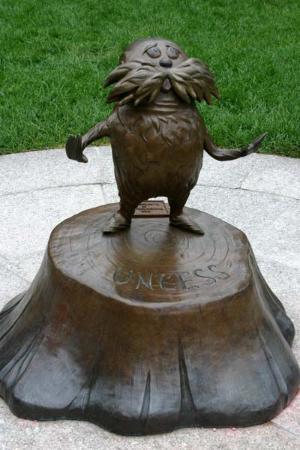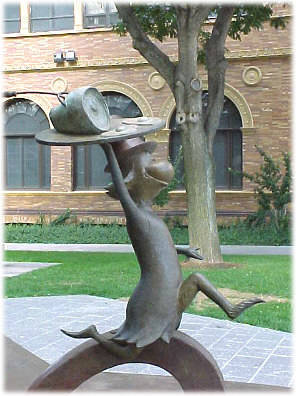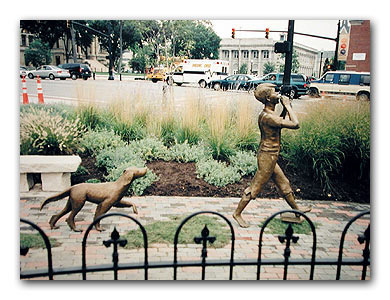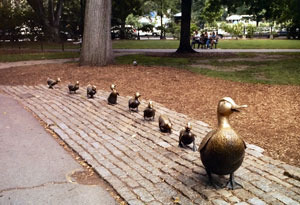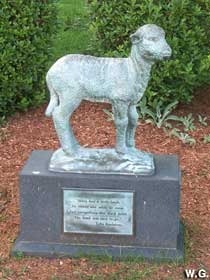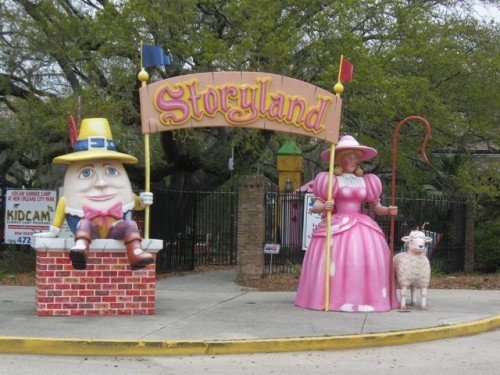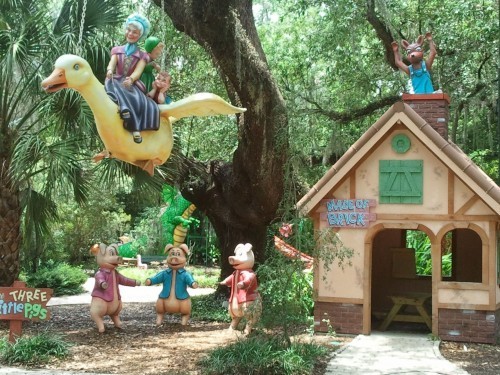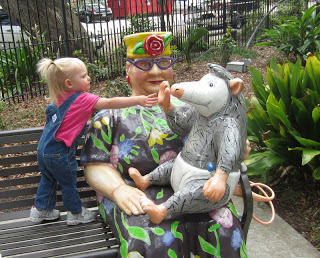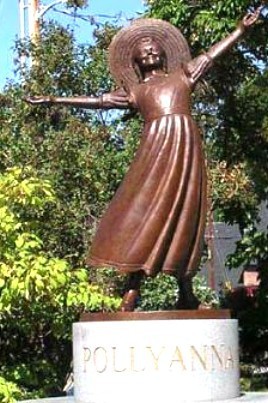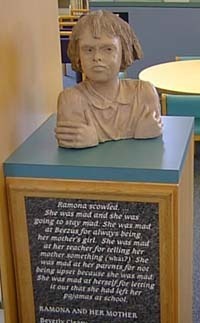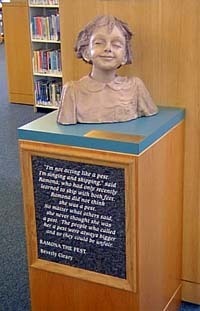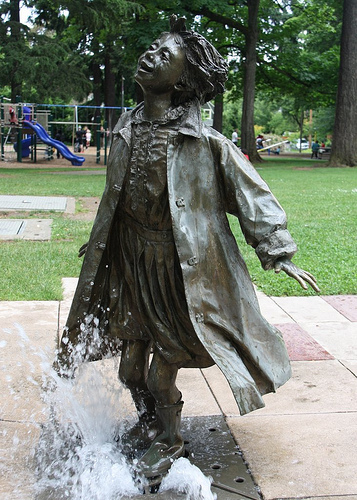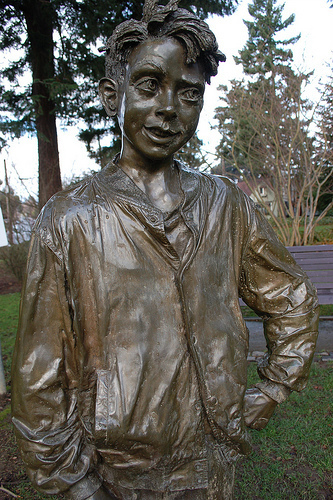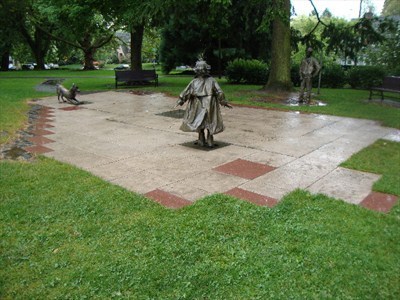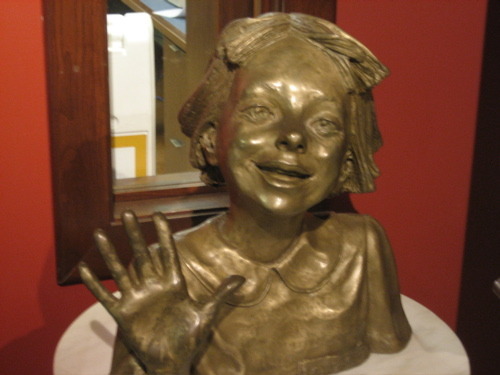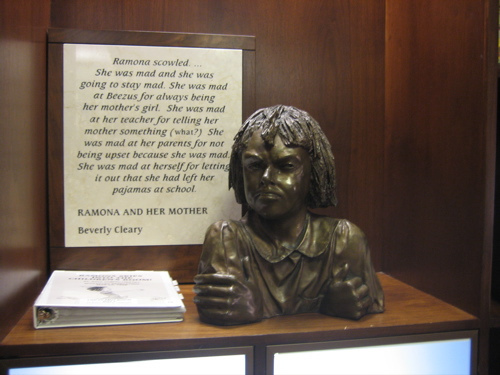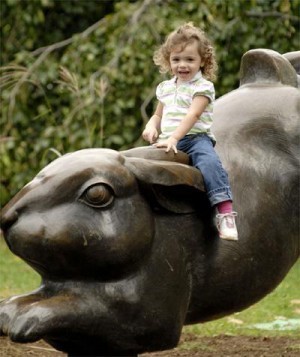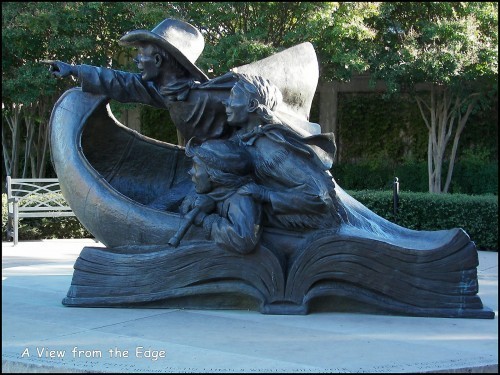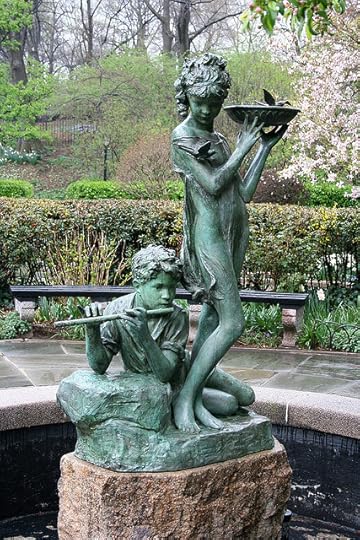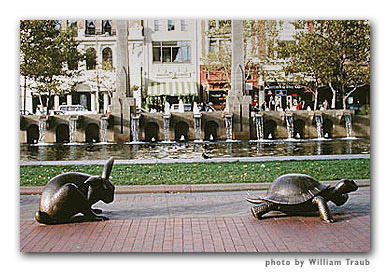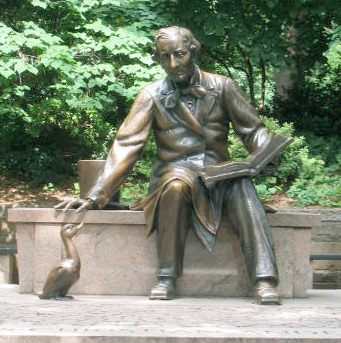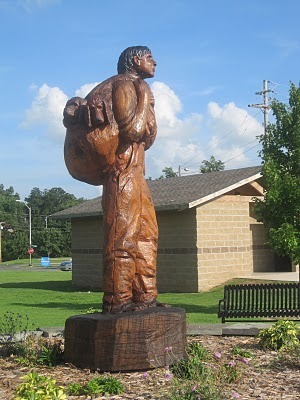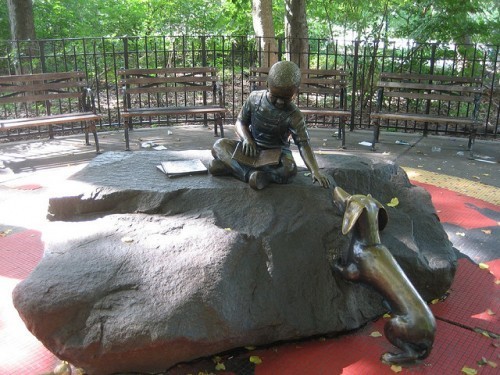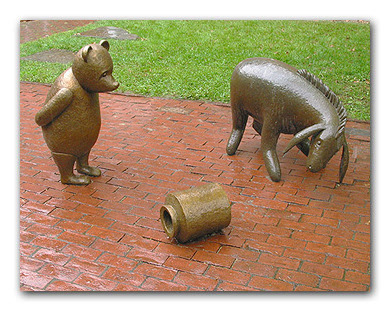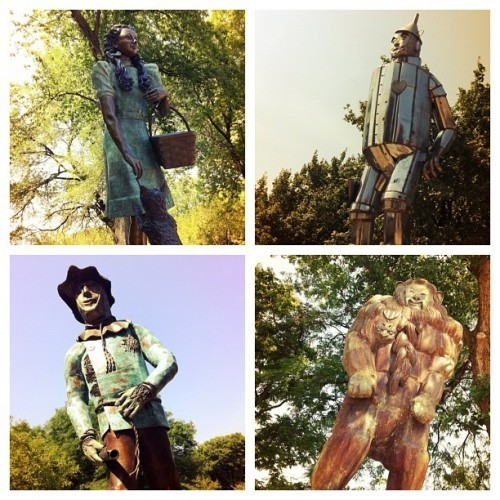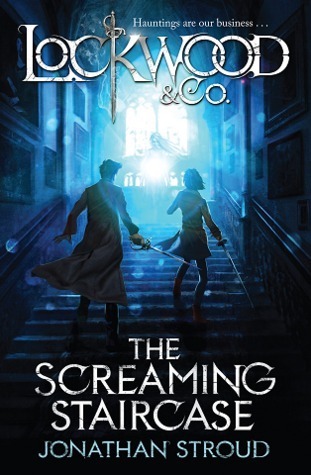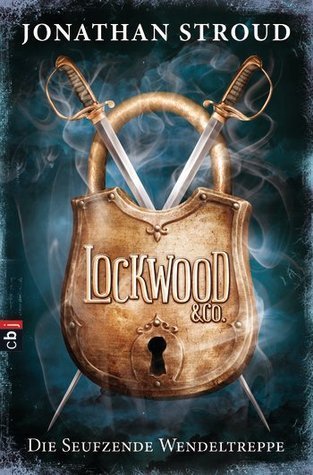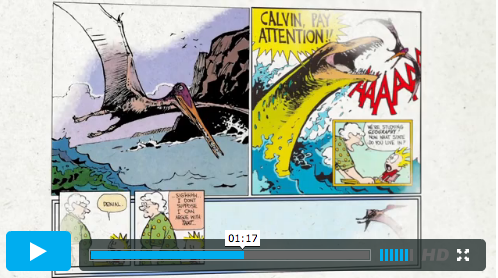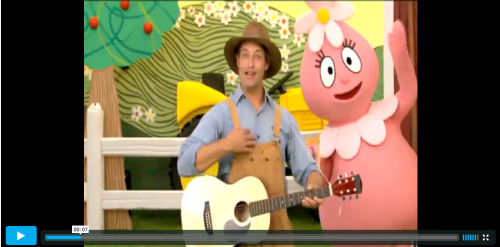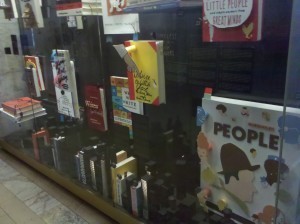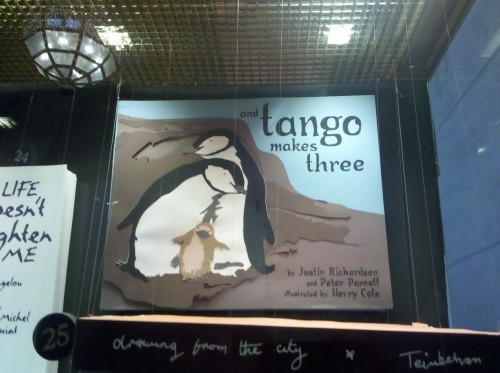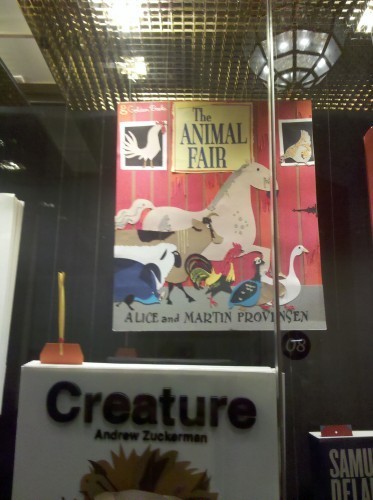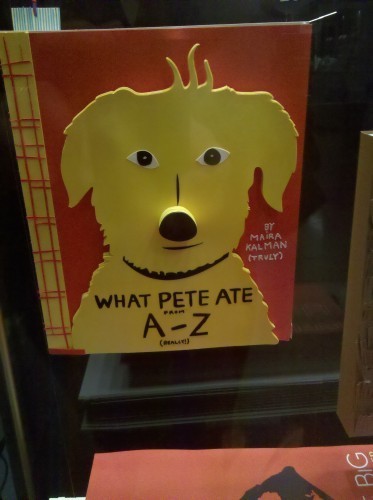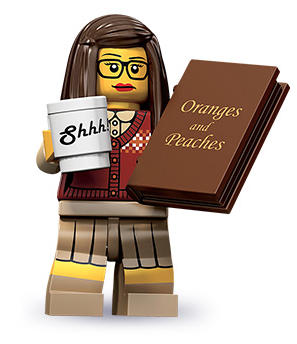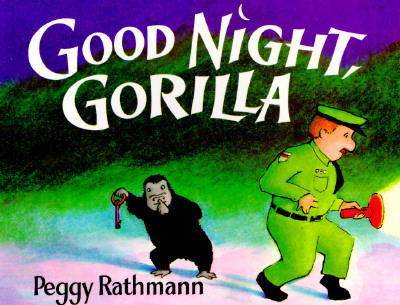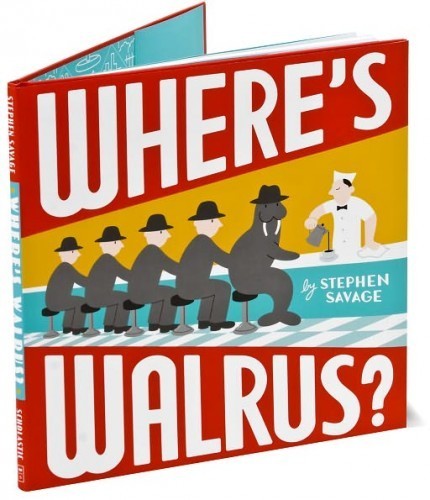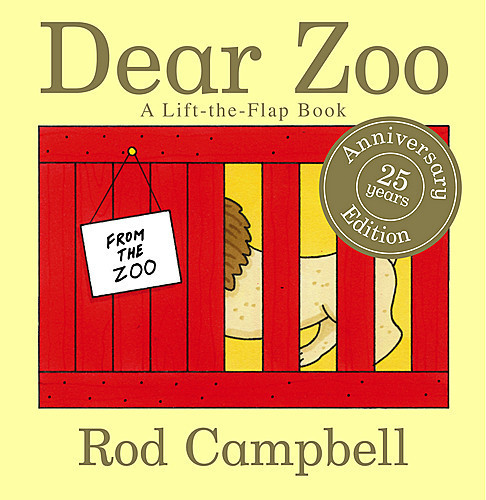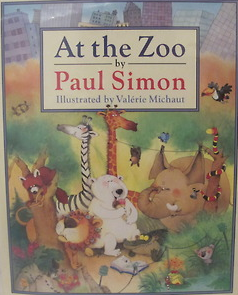Betsy Bird's Blog, page 306
August 21, 2013
Review of the Day: Rifka Takes a Bow by Betty Rosenberg Perlov
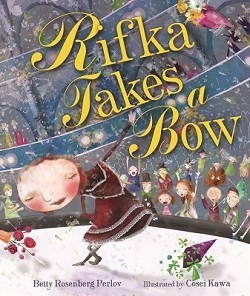 Rifka Takes a Bow
Rifka Takes a Bow
By Betty Rosenberg Perlov
Illustrated by Cosei Kawa
Kar-Ben Publishing (a division of Lerner)
$17.95
ISBN: 978-0-7613-8127-3
Ages 4-8
On shelves now.
History is written by the winners, they say. I’m going to lump personal history into that too. As far as I can tell, if you live long enough to tell an interesting story about your past, that’s winning. And anyone who lives a long time is going to have some kind of a story to tell. Time has the ability to make even the most mundane activities of the past of interest. That’s the reason books like William Stieg’s When Everybody Wore a Hat work as well as they do. When you write a picture book about the past you have to couch that story in the familiar and the unfamiliar in equal measure. Make the past too exotic and you risk losing your audience. Make it too familiar and then what’s the point of telling the story at all? Rifka Takes a Bow is a good example of a book that finds that balance and works it to the reader’s advantage.
Rifka’s parents have the best job in the world. Actors in the Yiddish Theater, they often will take their spunky daughter to work with them from time to time. It’s just a quick trip on the subway to Union Square and then up to Second Avenue where The Grand awaits. There her parents transform into old men or little girls depending on the show. Rifka explores the props in the basement and the dressing rooms of the actresses, but she doesn’t get into trouble until the day she accidentally explores a flight of steps that lead onto the stage during a live performance. Fortunately, the girl’s a born actress. She’s never been more at home. A note about the Yiddish theaters of the late 1800s / early 1900s and the author’s own experiences as a child are included alongside photos and playbills at the book’s end.
You would think there would be more picture books out there about backstage kiddos. Indeed it would feel like a wonderland to kids unfamiliar with the setting but familiar with the stageplay. Here you have a world where people pretend to be what they are not and who they are not on a regular basis. There are secret staircases and beautiful ladies in dressing rooms and mysterious people clothed all in black in the wings. Could it be more perfect? And yet when we hear about picture books set in such a world it tends to be from the p.o.v. of cats (Backstage with Clawdio, Backstage Cat, etc.). To do a proper backstage book it helps to have a bit of reality in there. A bit of memoir doesn’t hurt either. Hence, Rifka.
There must have been a temptation early on to make this book a straight up work of nonfiction. If we’re working off of Ms. Perlov’s 90-some year old memories, there have got to be some choice gems. But in the end I think the idea of making it fictional was wise. Picture book biographies have a tendency to get lost in the great swath of books out there for kids. Unless they’re about someone famous or they have a huge marketing push behind them, most of the time they get lost. Fiction that contains nonfiction elements, however, can be used in all sorts of different ways, whether it’s school assignments or personal readings. There’s also the freedom with the narrative that only fiction can truly provide. When you have only the truth to play with, you are severely limited in your storytelling. Here, fiction has the edge.
 But it is the setting that really sets Rifka apart from so many other picture books in the world. First of all, that it was written by someone who lived through a distinct period in the early 20th century is interesting. The number of 96-year-old debut picture book authors is not as high as you might think. Then there’s the information about the Yiddish theater scene of old New York. It’s not as if kids will necessarily care all that much about it either way. Far more interesting to them will be the many disguises an actor can put on and the kid-sized glamor of the behind-the-scenes world. On top of that, I think we’re all a little burned out by works of historical fiction that talk about Jewish characters but can’t seem to find a worthy setting other than the Holocaust. Maybe you’ll get a pogrom, but never anything happy. This book is, in sweet delightful contrast, distinctly cheery from start to finish.
But it is the setting that really sets Rifka apart from so many other picture books in the world. First of all, that it was written by someone who lived through a distinct period in the early 20th century is interesting. The number of 96-year-old debut picture book authors is not as high as you might think. Then there’s the information about the Yiddish theater scene of old New York. It’s not as if kids will necessarily care all that much about it either way. Far more interesting to them will be the many disguises an actor can put on and the kid-sized glamor of the behind-the-scenes world. On top of that, I think we’re all a little burned out by works of historical fiction that talk about Jewish characters but can’t seem to find a worthy setting other than the Holocaust. Maybe you’ll get a pogrom, but never anything happy. This book is, in sweet delightful contrast, distinctly cheery from start to finish.
I admit that I was surprised at the choice of Cosei Kawa as the illustrator. Normally with a story like this you’d employ a Vladimir Radunsky or Boris Kulikov for the art. Kawa is a relative unknown on American shores, usually illustrating books for Japan or the UK. But that’s what separates the good editors from the bad. Good editors take risks. They receive picture book manuscripts and then envision the kind of art that would best accompany it. On occasion, they even take risks. Kawa’s style is hardly the kind you’d immediately associate with historical fiction. It’s light and airy with little tiny flourishes and details. It feels simultaneously like a work of cut paper wizardry and computer generated art. Features might get pulled and twisted and even occasionally misplaced (Rifka’s nose has a habit of disappearing) but Kawa reigns everything in to keep it from crossing over into the creepy. It’s a fine, funny line to walk.
The only real problem I had with the book was the ending. At the story’s finish Rifka accidentally walks out onto the stage during a performance. In a burst of chutzpah she announces boldly, “Piff-Paff! Not to worry!” The crowd, for some reason, goes crazy for this and showers her in flowers and applause. Fair enough. You can read that as a triumph from Rifka’s point of view if not actual reality. But the last sentence in the story is, “I am going to act on the stage when I grow up!” Turn the page and you see information about the history of Yiddish Theater. Betty Rosenberg Perlov’s short bio is also included and it talks a bit about how her acting parents and how she was a “child star” on her father’s Yiddish radio soap opera. This followed by a bit of info on her growing up but nothing on whether or not she became an actress like Rifka in the story. It would have been nice to know. Ah well. That’s why we’re dealing in fiction here.
Part of what I like about child readers is that you never know what kind of book they’re going to gravitate towards. You might swear you can predict their tastes, and then they’ll turn around and surprise you. I can guarantee then that Rifka Takes a Bow is going to be some child’s favorite book somewhere. I know not where or even why. Maybe it’ll be the backstage elements that appeal. Maybe the automat or the subway or other New York details will be the allure. Or maybe it’ll be that final image of Rifka on the stage bowing to applause and cheers. Whatever the case, Ms. Perlov has penned a fun, frolicsome little picture book that pleases on multiple levels. One-of-a-kind and not one you’d like to miss.
On shelves now.
Source: Final copy sent from publisher for review.
Like This? Then Try:
Backstage with Clawdio by Harriet Berg Schwartz
When Everybody Wore a Hat by William Stieg
Backstage Cat by Harriet Ziefert
The Castle on Hester Street by Linda Heller
Professional Reviews:
A star from Kirkus
Publishers Weekly
August 19, 2013
Fusenews: Frosted Sheriff is part of a complete balanced breakfast
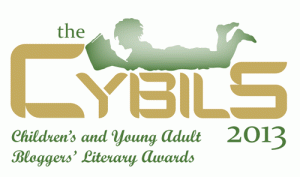 All right bloggy woggers. Woggy bloggers. Froggy woggy moggy snoggers. I’m having a silly day, it seems. In any case, the time has come once again for folks to apply to be Cybils judges. Basically if you have a blog about children’s or YA books and you’d like to be on a judging panel for the one and only children’s & YA blogger book awards, the Cybils has an open call going on right now. This year they’ve decided to call all fantasy and science fiction “Speculative Fiction”. There are some nonfiction changes as well. Check it!
All right bloggy woggers. Woggy bloggers. Froggy woggy moggy snoggers. I’m having a silly day, it seems. In any case, the time has come once again for folks to apply to be Cybils judges. Basically if you have a blog about children’s or YA books and you’d like to be on a judging panel for the one and only children’s & YA blogger book awards, the Cybils has an open call going on right now. This year they’ve decided to call all fantasy and science fiction “Speculative Fiction”. There are some nonfiction changes as well. Check it!Me Stuff: The kind and pleasant Deborah Lytton was nice enough to interview me recently about all kinds of things. If you’ve an interest in hearing me spout off about future trends, where the industry is going, what it lacks, and some of my favorite 2013 books synthesized down, go on over to Adventures in Writing.
This has absolutely nothing to do with anything else. I just find it interesting. My Little Pony parodied The Big Lebowski.
“Nikki Maxwell just came to me as a Caucasian little girl and when I sat down and made that decision I thought, ‘Well, I don’t know, what’s society going to think? I’m a black woman and can I do this?’” Rachel Renee Russell speaks with Michele Norris of NPR about writing The Dork Diaries series. Worth checking out.
The debate on whether or not to circulate apps in the library is one that I sort of slowly back away from and then take off running. Apps are still the wild west. There’s so much we can’t or don’t understand about them. That’s why I was so grateful to the PBS Newshour for sitting down with Dr. Michael Rich, Director of the Center on Media and Child Health at Boston Children’s Hospital to talk about apps and how they affect very young children. When speaking about the fact that there is no evidence that apps do anything good for one or two-year-olds, Mr. Rich mentioned something I thought was particularly interesting. Of the app developers he says, “They don’t dispute that there’s no research on this. And, interestingly, they don’t do any research of their own, which is kind of ironic in a business that does a great deal of research on their products to find out how well they will sell or how well they will do the job that they purportedly do.”
Like to make little round-ups of books, but I much prefer it when other people to my job for me. Take Paula Wiley. I’ll pretty much read anything she writes anyway. So when she talks about some of her favorite picture books of 2013, brother, you better listen up. Some real gems to be found here. Impeccable taste. And I completely missed that breakfast cereal in No Fits, Nilson!
All libraries are different and this list may pertain a touch more to adult books than children’s at times, but the gist of it is the same. If you ever wanted to feel sorry for a book, check out The Life of a Library Book. Thanks to Lese Duncan for the link.
If you had asked me what celebrity was most likely to act out my own personal nightmare, I don’t know that I would have necessarily have gone with actress Famke Janssen. Poor gal. This would make a stirring beginning to a psychological horror film, though.
Oh, I absolutely love it! Suzy Lee is the artist behind the latest National Book Festival poster. Ain’t it lovely?
By the way, I’ve been steadily adding more and more images to my Complete Listing of All Public Children’s Literature Statues in the United States. I’d say I’m about 60% done at this point, adding new suggestions every day. The Br’er Rabbit statues are my current favorites. I love the variety.
School season is just around the corner and that means finding some super starting school books. You’ll see all kinds of lists out there, sure. Recently Aimee Saboo of NYC’s Inside Schools site asked me to come up with some suggestions. I determined my five favorites. Check ‘em out at Kindergarten countdown: Best books to read!
We got the emergency message last week. Alert! Waldo is coming! More to the point, Waldo is now NYC’s Family Ambassador. Fair enough, but am I the only person out there who hears his name and immediately thinks of this?
I can’t be alone.
Regarding the fact that Trev Jones is leaving SLJ as the review editor: GAH!
Regarding the fact that Trev Jones is to be succeeded by Kiera Parrott: WOO-HOO! A remarkable choice. And not just because I’m fond of aviary-related last names. I worked with Kiera in the Jefferson Market branch of NYPL years ago. She’ll be stellar. You’ll see.
Does it matter what library school you went to? For years I’ve laughed off the notion of prestige library schools. Not because some aren’t better than others, but because no one will ever base their hiring on your school alone. That said, the blog post Yes, Virginia, it matters which library school you go to is a smart and nuanced understanding about why you really do want to research your library schools before you attend them. Not that a lot of us have a choice, considering geography and all that. But with the rise in distance learning, that may all be changing anyway. Thanks to AL Direct for the link.
Fair play to Mental Floss. I thought that maybe I would have heard of at least one of their Five Forgotten Grimms Fairy Tales, but nope. Not even Hurleburlebutz (my personal favorite) rings a bell. Thanks to AL Direct for the link.
AAH! Paul Giamatti. Oh boy, oh boy, oh boy . . .
Sunday, December 8 at 4:00pm
A Splendiferous Afternoon of Roald Dahl
Thalia Book Club Special Event to Benefit First Book—Manhattan, Featuring Paul Giamatti
Tickets: $25
Paul Giamatti leads a cast of actors in an afternoon of readings by the darkly comic master storyteller whose beloved novels include Charlie and the Chocolate Factory, Matilda, and James and the Giant Peach. Special musical guests to be announced.
This event is a benefit for First Book—Manhattan. First Book, a nonprofit organization, connects book publishers and community organizations to provide access to new books for children in need. Ages 8 and up.
Even more good news. The PEN/Steven Kroll Award for Picture Book Writing (which comes in at a cool $5,000) is a yearly award that goes to a writer for an exceptional story illustrated in a picture book. This year judges Barbara Shook Hazen, David Wiesner, and Cheryl Willis Hudson showed off their great good sense and selected The Fantastic Jungles of Henri Rousseau (Eerdmans), Michelle Markel. And, might I say, a better choice I could not have made.
Daily Image:
There are days that I suspect that when comedy sites have nothing better to do they just take inappropriate subject matter and turn it into faux Golden Books for quick laughs. That said, I love Simon Pegg, so anything that features him is a-okay with me. Here’s one of three images found at Laughing Academy.
Thanks to Marci Morimoto for the link.
August 15, 2013
Review of the Day: God Got a Dog by Cynthia Rylant
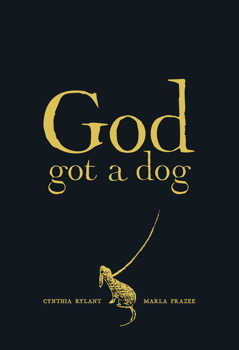 God Got a Dog
God Got a Dog
By Cynthia Rylant
By Marla Frazee
Beach Lane Books (an imprint of Simon & Schuster)
$17.99
ISBN: 978-1-4424-6518-3
Ages 9 and up
On shelves October 29th
I’ve been thinking a lot lately about whom children’s books are really for. Kids, obviously. And parents that will have to (hopefully, potentially) read those books over and over again. Children’s books are flexible objects, though. Their stated audience is in the 0-12 age range, but recently you’ve been seeing them used for other purposes. Graduates from high school get inspirational picture books to send them on their way. Psychiatrists keep picture books around for their patients, using them to work through various worries and anxieties. Adults gift them to one other because there’s something about the simplicity of a children’s book that can be infinitely comforting. So when we pick up a little book of poems like those in God Got a Dog we start by wondering who the intended audience is. Kids? Teens? Adults? The spiritual? The agnostic? After reading it through several times, I think my answer is, “Everybody”. The God in this book is everything from a nine-year-old girl to a broken man on a swing. If He can be anyone then this book is for everyone.
In this book you will find sixteen poems culled from author Cynthia Rylant’s 2003 YA title God Went to Beauty School and illustrated by the inestimable genius of Marla Frazee. Each poem relates a small attempt on God’s part to do something human. Sometimes he is successful (he opens a nail salon, goes skating, and finds God, which is a bit confusing for Him). Sometimes he is a bit dejected (He catches a cold, gets arrested, and gets a desk job that She (the gender shifts abound) only gets through because She eats thirty-seven Snickers bars). We see God’s highs and lows and He’s this infinitely relatable, great person. The final poem is “God got a dog” which ends with, “. . . She saw this dog and She felt bad so She took it on home and named it Ernie and now God . . .” a turn of the page, “has somebody keeping Her feet warm at night.”
You say the name “Cynthia Rylant” and you work in some capacity with children’s literature then you might conjure up any number of titles she’s written for kids over the years. Everything from the Henry and Mudge series to Cat Heaven to Poppleton and his friends, and on and on and on. What you may not immediately remember is her foray into the world of young adult literature. Normally when children’s authors write YA books they release realistic novels about kids very much like themselves breaking up, growing up, and generally facing the unfairness of the world. Rylant took a different tactic. She decided to write about God. It’s funny, but at its core the book was just as teen as anything by her kidlit fellows. But while those other teen characters were trying to figure out who they were, God is trying to figure out how our world works. He’s pretty clear on Himself. Except when it comes to body image. He’s still working on that.
The book does not include all the poems from the original collection. Just a small sampling really. I tried reading them to see if there was something infinitely more kid-friendly about these particular poems and was stumped. I think Rylant chose the ones in this book not because they would speak more to the prepubescent set but because they were the best ones from the previous book. Still and all the choice of which to use must have been fascinating. The order of the poems is also interesting, particularly when you consider that the titular poem is also the last one in the book. Mind you, it ends everything on a particularly hopeful note (I think the previous book ended with God getting killed), so you really wouldn’t have it any other way. For my part, I found myself doing something with this book that I didn’t remember doing with God Went to Beauty School. As I read I found myself wanting to learn the rules of this God. How do Jesus and Gabriel and Mother Teresa all fit into it? What does a disguise mean to him? Rylant just gives us the barest of outlines, but I already predict that a savvy young reader somewhere will work out all the tips and tricks and rules and ideas at work here. Things that Rylant never thought of. Things that can be extrapolated from the text.
And so we return to the age-old debate of audience. One of my children’s librarians recently commented to me that she will definitely be buying copies of this for her relatives come the Christmas season. Is this book then destined to be a thoughtful gift from one adult to another? Is it a graduation book to be given to high school seniors so that they can think about The Big Picture without having to get too “big”? Or is it actually for children after all? Kids raise questions about things that they don’t understand. It’s what they do and how they learn, so what better than to give them a book that feeds into that? Certainly the book is rife with adult jokes (God tells a doctor at one point that “you’re pretty good at playing me.” There are mentions of Jesus and circumcision and mourning. The best thing to say is that the book is for all ages, beginning with childhood. It’s for the kid who wants to think about God in a fashion not found in most titles for kids. I’ve been wracking my brain trying to come up with a children’s book that comes even a bit close to what Rylant and Frazee are doing here and I’m stumped. This is a book that trusts in the intelligence of its child readers, even as it attracts adults.
Here’s how old I am. I remembered reading God Went to Beauty School back in 2004 but I wasn’t sure if I’d reviewed it. So I headed over to Amazon to see and there, lo and behold, was my review. In it I wrote the following about the poems themselves, which I’ll stand by. To quote: “I have heard that Bible study groups use the poems to study. That groups of people without religion will ponder the poems line by line . . . I have heard that people have read the book at funerals. That it encompasses something in all of us, touching us deeply, revealing the truth that everything changes from one thing into another. The book is small and it does not impose itself upon you. It invites you to read it and whether you love it or hate it, it will not attempt to convert you one way or another. It is a book to love.” One thing I wish I’d mentioned at the time is Rylant’s humor. The poems are doggone funny at times. Like in “God caught a cold” when it says, “It’s hard to be authoritative with a cold. It’s hard to thunder ‘THOU SHALT NOT!” when it comes out “THOU SHALT DOT!” That’s just good plain writing. In my original review I also mention that my favorite poem was “God went to India”. I’m sticking by that, and they really know how to use it in the new collection. It’s the most serious of the poems, and the saddest.
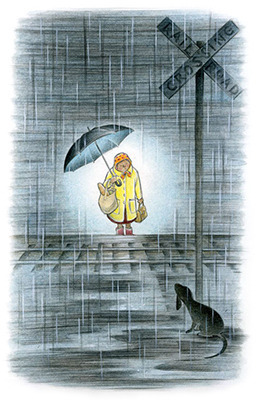 One change made from the original God Went to Beauty School to God Got a Dog is the personification of God as one gender or another. In the original book God was a He from start to finish. In this one, God has been broken into Hes and Shes, partly for the benefit of Ms. Marla Frazee, the illustrator. In terms of the art in this book, this collection could not have happened without her. I can’t imagine a single artist out there quite as capable as she to capture each poem to such a heightened sense of detail.
One change made from the original God Went to Beauty School to God Got a Dog is the personification of God as one gender or another. In the original book God was a He from start to finish. In this one, God has been broken into Hes and Shes, partly for the benefit of Ms. Marla Frazee, the illustrator. In terms of the art in this book, this collection could not have happened without her. I can’t imagine a single artist out there quite as capable as she to capture each poem to such a heightened sense of detail.
Part of the lure of the images here come from the fact that Ms. Frazee fills her pictures with loads of tiny details. A dead plant in “God got a desk job”. Stacked beer cans in “God got cable”. And since she makes each appearance of God a different race, gender, and age, the order of the people is interesting. The very first God you see is a middle aged guy with a receding hairline in red plaid pajamas sitting in a chair, coffee cup in hand. You look at it and assume that he’s going to be your hero for the rest of the book, but turn the page and there you’ll find that God now looks Samoan with a lovely tattoo on his right arm and a pair of Bermuda shorts. The amazing thing is that in spite of the changes to the God’s body, you never for one moment assume that this is a book about a bunch of different Gods. Clearly it’s the same guy, and I think kids are capable of picking up on that.
If I got to choose my favorite picture in the book it would be the image that accompanies “God wrote a book” in which God writes a book for a little boy and reads it to him because he couldn’t sleep. The God in this particular poem is a woman in her late 40s, early 50s, wearing a loose comfortable yellow shirt, green leggings, and lots of rings and bracelets. There are glasses too. She’s reading with an arm around the boy and her legs are angled sidewise in a rather pretty fashion. Sensible red and white striped shoes are on the ground. She looks like someone’s aunt or librarian. If someone were to read me a story at night, I’d want it to be her. There is also an old-timey crown the kids used to wear in the 1940s hanging off of a chair. I adore those things. Gotta love the details.
One vaguely wonders if some will consider the book irreligious, and considering that you have God worrying about things and doubting things, that answer is going to be yes. Of course. But I consider it akin to something on par with Godspell or Jesus Christ Superstar. It’s interesting, maybe saying more about the human condition and our own relationship to God than God Him/Herself. Or maybe it’s a way of humanizing something that feels distant for some people. For kids, it makes God relatable and infinitely likable. And while I think it’s appropriate for children, I certainly don’t think this book is solely for them. This is a title for all ages and all comers. Get it while it’s hot people. Get it while it’s hot.
On shelves October 29th
Source: Galley sent from publisher for review.
Like This? Then Try:
The Book of Everything by Guus Kuijer
Millions by Frank Cottrell Boyce
Big Momma Makes the World by Phyllis Root
Professional Reviews:
A star from Kirkus
Publishers Weekly
Misc: Steps and Staircases has your Poetry Friday round-up today. Head on over there to check it out!
August 14, 2013
The Complete Listing of All Public Children’s Literature Statues in the United States
Write a title to your blog post like that you are just SETTING YOURSELF UP for trouble. But I like trouble. I eat it for breakfast. Or, at the very least, gnaw on it idly at lunch.
In the past I’ve noted each appearance of a statue pertaining to children’s literature when it crops up, but I’ve never been particularly systematic. That ends today! This post, which I shall continually update with your points and suggestion, shall serve as a place to find all statues pertaining to books for kids residing in the continental U.S. where they can be viewed regularly. Those are the parameters. Should someone ever wish to do a road trip in which they visit of them (meaningful glance) I would love to see a map indicating the location of each of these. I will also note the sculptor whenever I am able but I warn you that I am lazy and haven’t been able to track them all down. Here are the results:
Alphabetical by Book Title / Nursery Rhyme
Book: Alice’s Adventures in Wonderland
Location: Central Park, New York City, NY
We all know this classic Alice statue that kids somehow manage to climb all over without killing themselves in the process (a miracle in and of itself). My heart, however, belongs to a much lesser known statue featuring Alice & Co. in the nearby Levin playground.
Book: Alice’s Adventures in Wonderland
Location: Levin Playground, Central Park, New York City, NY
It has a monkey spitting water at you. What more do you need?
Book: Alice’s Through the Looking Glass
Location: The White Marsh branch of the Baltimore County Public Library, MD
Sculptor: William F. Duffy
Boy, I would love to see this someday. Isn’t it gorgeous? Sadly that’s as big a photo of it as I was able to find. You can read the artist’s thoughts on their creation here.
Book: Blueberries for Sal
Location: Boothbay Harbor, ME
Sculptor: Nancy Schön
Remember the name “Nancy Schön” because it’s going to come up more than once here. In 2008 she was commissioned by the Board of Directors of the Coastal Maine Botanical Gardens to make a sculpture of Little Bear from the book Blueberries for Sal by the author Robert McCloskey. The result is this cute little feller who is surrounded by actual honest-to-goodness blueberry bushes. You can read more about it and see Ms. Schön’s process here.
Book: The Dinosaur Who Lived in My Backyard
Location: Stagecoach Park, Evergreen, CO
Sculptor: Greg Wasil
Based on a book by B.G. Hennessey, I always assumed that Bob here was based on Bill Joyce’s Dinosaur Bob. Not the case! Check out more info on Bob here.
Books: Everything by Dr. Seuss
Location: The Dr. Seuss National Memorial at The Quadrangle in Springfield, MA
Can you believe that this is just a small sample of the statues you’ll find in this remarkable place? To learn more about it, go here.
Book: Lentil
Location: Hamilton, OH
Sculptor: Nancy Schön
In 2010 Ms. Schön was honored by The Eric Carle Museum for her work in the field.
Book: Make Way for Ducklings
Location: Boston Public Garden, Boston, MA
Sculptor: Nancy Schön
Probably her most famous work, and certainly quite lovely. It’s great to see how they get dressed up at different times of the year.
Title: Mary Had a Little Lamb
Location: Meetinghouse Hill Rd, Sterling, MA
You can find some info on the lamb here. And, naturally, there is the controversy that surrounds it.
Title: Mother Goose and other nursery rhymes
Location: Storyland, New Orleans, LA
NPR reported when Storyland took a hit after Hurricane Katrina. All told, it seems to be operating as per usual at this time. And you wouldn’t necessarily know it from the outside, but if you go in you’re likely to find . . .
Book: Epossumondas (yes, I’m mucking with the alphabetical order here a tad)
Location: Storyland, New Orleans, LA
Makes sense. Author Coleen Salley was a famed New Orleans denizen after all. Odd we haven’t any Bill Joyce in that town.
Book: Pollyanna
Location: Littleton, NH
Sculptor: Emile Birch
Okay. So I am officially in love with Littleton, NH. And after reading this little piece about their town, you will too.
Title: Ramona Quimby
Location: Gresham Regional Library of Gresham, OR
Sculptor: Lee Hunt
The first of MANY Ramonas to come.
Ramona Quimby, Henry Huggins & Ribsy
Location: Beverly Cleary Sculpture Garden, Grant Park, Portland, OR
Sculptor: Lee Hunt
The most famous Ramona statues are the ones found in this lovely park. I’ve visited them once or twice and they’re spectacular. Very well loved and tended.
Ramona Quimby
Location: St. Paul Central Library, St. Paul, MN
Actually, I’m pretty sure I have one too many statues here. As I recall the St. Paul Library only has two Ramona busts. Whence the third? Help me out here, readers.
Book: Runaway Bunny
Location: Westerly, RI
This little bunny suffered some serious vandalism recently, but I believe everything’s been cleaned up nicely by this point. Feel free to pay him a visit.
Book: Santa Calls
Location: The National Center for Children’s Illustrated Literature, Abilene, TX
Book: The Secret Garden
Location: Botanical Gardens, Central Park, New York City, NY
Yes, Virginia. There really is a Secret Garden statue and tribute to Frances Hodgson Burnett hidden away in Central Park. Though these two are supposedly Mary and Dickon, I’m a bit skeptical. Dickon maybe. Mary? Not so sure. The plaque that you’ll read on the ground, however, makes it pretty clear what this is supposed to be.
Title: The Tortoise and the Hare
Location: Copley Square, Boston, MA
Sculptor: Nancy Schön
Actually the artist has a great series of Aesop’s Fables in sculpture. Check ‘em out here.
Book: The Ugly Duckling
Location: Central Park, New York City, NY
Though Mr. Hans Christian Andersen gets all the attention, it’s the little duckling I love. I’ve done storytelling in front of this statue and it is bracing stuff.
Book: Where the Red Fern Grows
Location: Idaho Falls Public Library, Idaho Falls, ID
Sculptor: Marilyn Hansen
One of the best library statues I’ve seen. More information on it can be found here. And what’s amazing to me is that it’s not the only statue from that book in the world.
Book: Where the Red Fern Grows
Location: Sequoyah Park, Tahlequah, OK
There’s even a Red Fern Festival to accompany it.
Book: Whistle for Willie
Location: Prospect Park, Brooklyn, NY
Sculptor: Otto Neals
Yep. That’s Ezra Jack Keats’ Peter from The Snowy Day, Whistle for Willie, and so much more. Herein lies the very last children’s literature related location I need to get to before I someday leave NYC. But it’s Brooklyn. SO far away . . . You can read more about the statue here.
Book: Winnie-the-Pooh
Location: Newton Free Library of Newton, MA
Sculptor: Nancy Schön
As the story goes, Eeyore was established in 1991. But he looked so sad that Pooh was made in the memory of Sarah Oliver who had written the mayor asking for Eeyore to have a friend.
Book: The Wonderful Wizard of Oz
Location: Oz Park, Chicago, IL
Sculptor: John Kearney
In the past their plaques have been stolen, but at least the statues themselves have remained intact.
I know this can’t possibly be complete, so let me have ‘em. What other public American sculptures can you name?
August 13, 2013
Press Release Fun: An Evening at the Met with Oliver Jeffers (and it’s free)
Free Lecture
An Evening with Oliver Jeffers
Friday, August 16, 6:00–7:30 p.m.
Bonnie J. Sacerdote Lecture Hall, Uris Center for Education, The Metropolitan Museum of Art
Join award-winning artist Oliver Jeffers for a presentation about his creative journey, his work in various formats, and exciting upcoming projects. Meet the artist and explore the Museum until it closes at 9:00 p.m.
From figurative painting, collage, and installation art to illustration and picture book–making, Oliver Jeffers’s practice takes many forms. His distinctive paintings have been exhibited in multiple museums, including the National Portrait Gallery in London and the Brooklyn Museum in New York. HarperCollins UK and Penguin USA publish his picture books—now translated into over thirty languages—including The Incredible Book Eating Boy and the New York Times bestsellers Stuck and This Moose Belongs to Me. Working in collaboration with Studio AKA, Oliver developed his second book, Lost and Found, into an animated short film, which has received over sixty awards including a BAFTA for Best Animated Short Film. Oliver won an Emmy in 2010 for his collaborative work with artist and filmmaker Mac Premo. He has made art for Newsweek, the New York Times, United Airlines, TED, and Nintendo, and has illustrated a number of chapter books. Oliver grew up and was educated in Belfast, Northern Ireland, and now lives and works in Brooklyn, New York.
To register, please use the online registration form.
Seating is available on a first-come, first-served basis. Direct any questions to nolen.library@metmuseum.org.
This event is made possible by the Friends of Watson Library at The Metropolitan Museum of Art.
Please note the event is free with museum admission, but registration is required.
August 12, 2013
Review of the Day – Lockwood & Co.: The Screaming Staircase by Jonathan Stroud
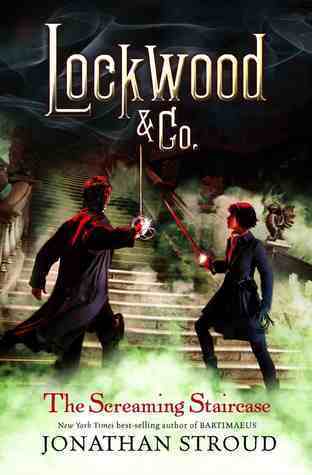 Lockwood & Company: The Screaming Staircase
Lockwood & Company: The Screaming Staircase
By Jonathan Stroud
Hyperion Books for Children
$16.99
ISBN: 978-1-4231-6491-3
Ages 10 and up
On shelves September 17th
I’m sick of historical fiction. I’m sick of contemporary fiction. I’m sick of realism and science fiction. Fantasy I watch with a wary eye. I don’t always feel this way but when I’ve read seven depressing meaningful middle grade books for kids in a row the old noggin screams for something enjoyable for once. And to place into this mental desert a book like The Screaming Staircase … well, it’s the best possible cure for what ails ye. A pleasure from tip to tail, this is the book you hand the advanced readers that claim they’d rather read Paradise Lost than Harry Potter. Smart as a whip, funny, witty, and honestly frightening at times, Stroud lets loose and gives readers exactly what they want. Ghosts, kids on their own without adult supervision, and loads of delicious cookies.
It all began with The Problem. One day, for no apparent reason, the dead started to walk amongst the living. Not just walk, but really wreak some serious havoc. Here are the facts of the matter. 1. If you see a ghost, run. 2. Don’t let a ghost touch you, or you’re dead. 3. Only kids can see ghosts. What are we to make of these facts? Well, it’s no surprise when ghost-busting operations hiring children start cropping up. Enter Lockwood & Company. Run by the charming Anthony Lockwood alongside his two compatriots Lucy and George the ramshackle operation is barely scraping by. Enter a job that goes particularly wrong when the kids accidentally burn down their employers’ home, and it would take a miracle to save the agency. Fortunately, a miracle shows up in the form of a very rich and powerful man. He’s hiring the three to take on the most haunted house in all of Britain. The catch? No one’s ever gotten out of it alive. Will our intrepid heroes take on the job, or is there more at work here than meets the eye?
There is no debate surrounding the joy one feels when reading this book. It is already beloved. Even without his popular Bartimaeus series, Stroud could have debuted with The Screaming Staircase and garnered legions of fans upon impact. That is not to say that it is without debate, however. Indeed, there is one point of contention that is raised when people learn of this book. In a word: audience. Can one honestly hand this book to a savvy 11-year-old reader without so much as a blink, or should you give it to a teen instead? In my experience I’ve noticed that before people have read the book they look at it and instantly assume it’s YA (young adult). Whether it’s the plot description or the cover or what have you it seems teen to them. However, once they’ve actually sat down and read the book cover to cover, most folks I’ve spoken to agree that it’s just fine for the juvenile crowd. Is there more blood than you can shake a stick at? Sure. But it’s ghost blood. Hardly the same thing. The closest thing I can compare it to is Joseph Delaney’s first book in The Last Apprentice series, Revenge of the Witch. Scary but not inappropriate, which is a delicate line to walk. It doesn’t hurt matters any that the kids in this book never give their ages. They’re on the cusp of adolescence, sure, but the fact that there are no allusions to crushes or palpitations of the heart is significant in its absence. It’s kind of the perfect thing to hand that kid who can’t stand even a whiff of romance in their fiction.
At its heart this is a great book to scare a kid with. Over the years I’ve noticed that love of horror begins at a very young age and never seems to go away. I used to have a four-year-old come to my reference desk in the library over and over asking for “scary” books. Pretty much as long as I could hand him something with a vampire or a monster on the cover, he was content. Once they start reading on their own, many kids gravitate to the Goosebumps section of their library. Low-key horror thrills, tailor made for the 7-10 year-old set. But as with all things, kids outgrow fads. They find Goosebumps babyish. They want something with a little more bite. So rather than hand them Miss Peregrine’s Home for Peculiar Children quite yet, I need something that will run a finger down their spines without tripping wholly into teen territory. In the past the aforementioned Revenge of the Witch was my go to book. Now The Screaming Staircase will serve just as nicely.
One point that I’m in danger of not mentioning is the fact that the book is bloody funny. Who else could get away with a sentence like, “..George Cubbins, handsome as a freshly opened tub of margarine, as charismatic as a wet tea towel lying scrumpled on the floor”? Scrumpled. Delicious. Actually, Stroud is at his best when Lucy is describing George. “With his glasses off, his eyes looked small and weak – blinky and a bit baffled, like an unintelligent sheep that’s taken a wrong turn. But when he put them on again, they went all sharp and steely, more like the eyes of an eagle that eats dumb sheep for breakfast.” All throughout the story you are in Lucy’s head and though she is allowed to make her own fair share of stupid mistakes (no Hermione Granger she, thank heavens), you like her snarky sense of the absurd. Lucy actually acts as a kind of Watson to Lockwood’s Holmes, but not the bumbling Watson we’re so familiar with these days. She’s got a good head on her shoulders. You come to like her compatriots too, for that matter. A wittier crew you won’t find this year.
Above and beyond the humor, however, there’s much to be said for Stroud’s actual writing. As I mentioned before, you love the characters. The plot and mystery components play fair (and I admit that I didn’t suspect the true villain of the piece when I probably should have). But it’s the wordplay that gets me. Consider a sentence like this: “In fact, it wasn’t at all an ugly hallway; in bright sunlight it might have looked quite pleasant. But not so much now, with the last light from the door panes stretching out like skewed coffins on the floor in front of us; and with our shadows neatly framed inside them..” Or, later, my favorite part is when Lucy is naming her old partners in the ghost busting business. “We worked together. We had fun. We saved each other’s lives a bit. Their names, if you’re interested, were Paul, Norrie, Julie, Steph, and Alfie-Joe. They’re all dead now.” It’s just a little twist of the knife, but it gets the job done.
There are some moments of British-to-American translation that rankled me but will pass unnoticed by the general child population. Lucy is continually talking about “tea and cookies”, a phrase guaranteed to jar in the head of this particular Anglophile. My suspicion is that this was a true “tea and biscuit” book from start to finish, but that biscuits have an entirely different connotation in the States and as a result the word was switched. Other switches passed me by unnoticed, which is to their credit. Pity about the cookies. Still, it’s a remarkably mild complaint to make. Cookies schmookies. The book’s a pip.
You would be forgiven for thinking this book a work of historical fantasy fiction, were it not informing you left and right of its contemporary nature. Velcro holds the rapiers in place, for example. In another moment a television is mentioned. Yet there’s something classic in its form. I suppose you could technically call the story post-apocalyptic, if you consider the apocalypse in question The Problem. You could call it a straight up horror story. Or you could turn around and label it a mystery. And what about fantasy? It’s definitely in that genre as well. Howsoever you feel like labeling it, there’s one thing you can certainly label the book: good. It’s a delight from start to finish and after you’ve devoured it you find yourself craving more more more. For everyone then. Child, teen, adult, or slow shuffling specter, this is a book for you. Try it on for size.
On shelves September 17th.
Source: Reviewed from galley sent from publisher.
First Line: “Of the first few hauntings I investigated with Lockwood & Co. I intend to say little, in part to protect the identity of the victims, in part because of the gruesome nature of the incidents, but mainly because, in a variety of ingenious ways, we succeeded in messing them all up.”
Like This? Then Try:
Enola Holmes: The Case of the Missing Marquess by Nancy Springer
The Invisible Detective: Paranormal Puppet Show by Justin Richards
The Last Apprentice: Revenge of the Witch by Joseph Delaney
The Ear, the Eye and the Arm by Nancy Farmer
Alternate Jacket Art:
I’m always a fan of how other nations chose to illustrate their jackets. Thus far, only two others are available straight out of the gate, but they’re lovely.
Britain:
Germany:
Other Blog Reviews:
Bookends
Mr. Ripley’s Enchanted Books
Kid Lit Geek
Librarian in a Candy Shop
Professional Reviews:
Publishers Weekly
Kirkus
Other Reviews:
Science Fiction World
Misc:
Read the first four chapters here.
Listen to some of the audiobook here.
No one’s lost any time on this one. The book has already been optioned for a film.
Even Robin McKinley likes it!
Video:
The VERY excellent book trailer by the British publishers of this title is not to be missed. The best of its kind.
August 11, 2013
Video Sunday: “You know what? No. I’m not gonna apologize. That cat was delicious.”
We’re a bit booktrailer top heavy this week, but after you see some of the beauties I’ve got lined up I don’t think you’ll mind. Heck, if nothing else this first one will convince you:
Why there is not a national alert to tell us when Dan Santat has created a new book trailer, I’ll never know.
I admire bare bones book trailers. The kinds that were clearly shot in your backyard by yourself, your five-year-old, and a much maligned Barbie. As long as its creative and smart, I’m on board. On the flipside, I admire book trailers where it’s clearly that a TON of work went into the doggone things. Case in point, Dinosaur Kisses by David Ezra Stein. Never mind the claymation. Never mind the lighting. Let’s just pause for a moment and think about how they had to commission a song and find a singer and then record THAT even before they made the trailer. Madness! Dinosaur madness.
In the trailer for Dan Yaccarino’s Doug Unplugged there is almost much to be said for background music. Background music you wouldn’t necessarily find in Garage Band, I should say. I think I have all those tunes memorized by now.
You know, we could learn a thing or two from the British. When their authors and illustrators win awards they do a series of videos about each person for one and all to see. That is awesome! Why don’t we do that with Caldecott and Newbery? C’mon, ALSC! Travis Jonker was my source for this particular tidbit of news and then he went and proceeded to post FOURTEEN videos of Emily Gravett talking about her book process on the fantastic picture book (now available in the States) Again! I could steal one of those vids and put it here but Travis put so much bloody work into this that I am directing you there. Go! Shoo! Leave me! It’s worth it.
I will, however, steal this link because it is awesome incarnate. All I need to say is this: A Bill Watterson Documentary.
More info on the film here. Thanks, Travis!
The off-topic video this week was freakishly easy to find. This one’s for the LOST fans. It’s Josh Holloway. On Yo Gabba Gabba. Note: You cannot unsee what you see here:
August 9, 2013
The NYPL Exhibit You Won’t Hear as Much About
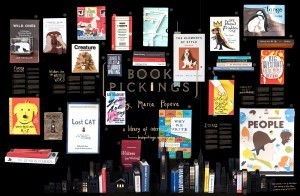 All the talk in the press and the news recently has concentrated on New York Public Library’s current children’s literary exhibit The ABC of It, as curated by Leonard Marcus. It is, justifiably, remarkable. But exit the exhibit and you’ll find that it’s not the only children’s literary piece going on in the library at this time.
All the talk in the press and the news recently has concentrated on New York Public Library’s current children’s literary exhibit The ABC of It, as curated by Leonard Marcus. It is, justifiably, remarkable. But exit the exhibit and you’ll find that it’s not the only children’s literary piece going on in the library at this time.
When you leave the exhibit and look to your immediate left you’ll see the bookstore. And should you choose to not to enter but, instead, to walk around it, you’ll find a window display to beat all window displays. A window display for the ages. Ladies and gentlemen, I give you the The Best Books on Writing, NYC, Animals and More. The “more” refers to “Timeless Treats for Young Readers”.
Created by Brain Pickings author Maria Popova, the exhibit was created after NYPL asked Maria to curate a selection of books for the bookstore. Maria chose the books. Then she collaborated with artist Kelli Anderson to make the book jackets come to life. In the end, Kelli decided to turn a number of book covers into 3-D paper sculptures that pop out at the viewer as you look at them.
I think what struck me about the exhibit the most was the choice of children’s books included. Because as much as I love Blexbolex, I don’t often see his book prominently displayed (or even remembered half the time). Yet there he is, alongside a ton of other heavyweights. Here’s a quick glimpse of some of the inclusions:
All became much clearer to me when I headed over to Brain Pickings and looked at their list of The best children’s books of 2012. Maria is massively fond of the more artsy and artistic children’s books out there and it shows. At the same time, though, she pays tribute to classic artists like the Provensens and the more recent titles like And Tango Makes Three.
To hear about the project from Maria’s point of view go here.
To hear about the project from Kelli’s point of view go here. Both posts include videos of the exhibit as well.
August 8, 2013
Fusenews: “Who is Fishface, and where can I find him?”
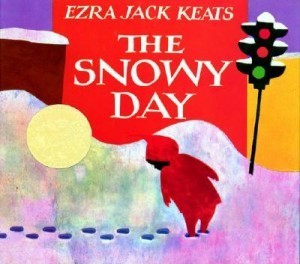 Required Reading of the Day: Roger Sutton already told you to read it, and now I’m backing him up. If you have not cast thine eyes upon Christopher Myers’s piece Young Dreamers in which he talks about the Trayvon Martin decision as well as Christopher’s own role in the world of children’s literature and the ultimate black character in a red hoodie (
The Snowy Day
, of course) . . . well, it’s the best damn thing I’ve seen in a long time.
Required Reading of the Day: Roger Sutton already told you to read it, and now I’m backing him up. If you have not cast thine eyes upon Christopher Myers’s piece Young Dreamers in which he talks about the Trayvon Martin decision as well as Christopher’s own role in the world of children’s literature and the ultimate black character in a red hoodie (
The Snowy Day
, of course) . . . well, it’s the best damn thing I’ve seen in a long time.Someday, when you have been very good and eaten all your peas and carrots, I will tell you the story of how my husband and I met. It’s a good tale. It involves Jimmy Stewart and library chase sequences and the human brain’s capacity to hold onto information for five years at a time. I thought of my How We Met story when I saw the recent NPR piece Libraries’ Leading Roles: On Stage, On Screen, and in Song. A lovely little ode to libraries in all their myriad forms, it will do your heart good to listen to it today. Enjoy!
In other news, Boing Boing recently discovered the real reason why E.B. White wrote Charlotte’s Web. I thought I knew every Charlotte story but apparently I didn’t know this one. It reminds me of the fate of the real Make Way for Ducklings ducks . . . but that is a tale for another day.
If you know me then you know that even if I worked for the smallest library system in the continental United States I would still be talking about it day and night like it was the bee’s proverbial knees. Instead, by some bizarre quirk of fate, I work for New York Public Library, big stone lions and all. And so it is with a bit of pride that I direct you to this fun infographic of NYPL stats. It’s just the fact, ma’am. Just the facts.
While Publishers Weekly’s Spring Sneak Previews are fun anyway, this batch is particularly keen. You might want to check out that Candlewick section there. Roundabout where it mentions, “Wild Things!: Acts of Mischief in Children’s Literature by Betsy Bird, Julie Danielson, and Peter Sieruta, a collection of essays offering a behind-the-scenes look at favorite children’s books.” Woot!
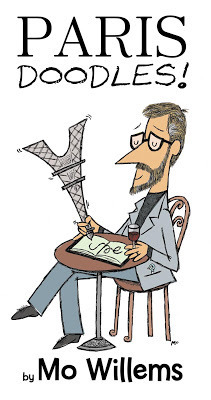 Where be Mo? Mo be not here. Mo be away. Far far away. Bye-bye, Mo.
Where be Mo? Mo be not here. Mo be away. Far far away. Bye-bye, Mo.
It’s sufficiently snarky and some of the questions are obviously just there for padding but Buzzfeed’s 22 Questions “Willy Wonka & the Chocolate Factory” Left Unanswered is worth reading if only for Fishface and the “bean feast” alone. I want a bean feast too now. Thanks to 100 Scope Notes for the link.
Speaking of Buzzfeed, they’ve been good to us as of late. If you haven’t read their 28 Things That Happened After the Harry Potter Books Ended, all corroborated by J.K. Rowling then you’re missing out. Plus fan art is always cute.
Aw, heck. I just can’t get enough of these lists. Good thing too since NPR just released their The Ultimate Backseat Bookshelf: 100 Must-Reads For Kids 9-14. Our own Travis Jonker of 100 Scope Notes served on the committee amidst such powerhouses as Rita Williams-Garcia, Linda Sue Park, and others. Ah, to have been a fly on the wall for those conversations. They cleverly make the series their own submissions and it’s a mix of old and new. Mostly old but that’s no crime.
This past Newbery/Caldecott Banquet I had the unique pleasure of getting a chance to meet the winners of the 2013 Penguin Young Readers Group Award. That’s the award that gives a $600 stipend to librarians who have never attended an ALA Annual Convention before. Good news too. The 2014 Penguin Young Readers Group Award is now taking submissions for next year. Sign up, sign up! What do you have to lose?
Well, you’re just asking for trouble if you call your post 9 Popular Yet Terrible Kids Books. The Baby on Bored blog at Babble gave it a go, and it begins well enough with the usual suspects (Giving Tree, Love You Forever, Skippyjon Jones, etc. But around the point you’re seeing Green Eggs and Ham and Good Night, Gorilla, you sort of have to mentally check out. Ah well. Still makes for good reading. Thanks to PW Children’s Bookshelf for the link!
Daily Image:
In the event that your Nancy Pearl action figure is feeling a bit lonely, there is good news to be had. LEGO has now created a librarian to their set. Better still, her hair isn’t in a bun.
The crazy part of all this is that the book she is carrying is an oblique reference to the librarian movie Party Girl. To understand more you must check out Mr. Librarian Dude’s magnificent post on the topic where he also creates an additional 28 other librarian LEGO characters. Thanks to AL Direct for the link.
August 7, 2013
Picture Book Occupational Hazards: Zookeepers
Bah. Rabble rousing is too much work. Let’s take a break today and talk about occupations as they exist solely in the world of children’s literature.
These days my little Bird is a bright and sprightly 2-year-old chock full o’ glee. Reading through her books with her, I recently noticed that certain jobs come up over and over again. Policemen certainly. Firefighters obviously. And then there are the zookeepers. Zookeepers, insofar as I can tell, are the much maligned, too little appreciated tenders of the animals in our books. When kids say what they want to be when they grow up, how often do they say they want to be zookeepers? One would think it would be a HIGHLY popular future occupation. Perhaps how zookeepers are presented in books for kids holds the key.
First off, I was surprised in my research to find shockingly few zookeepers starring in their own books. There’s Zookeeper Sue by Chris Demarest, of course. This is one of the rare female zookeepers you’ll find in books that aren’t nonfiction. For the most part, they’re bumbling, incompetent, or they have a cold. The usual suspects include:
Good Night, Gorilla by Peggy Rathmann
Our zookeeper in this particular case falls into the bumbling category. How else to explain his inability to notice/hear/smell the small army of animals that follow him on padded feet out of the zoo and into his own bedroom? Goodnight, Gorilla is notable here in part because it’s one of the few books that shows a zookeeper’s home life. As the animals walk down the hall there are multiple portraits of the zookeeper and his wife (whom I am convinced may well be a zookeeper herself) pose with various beloved animals from over the years. And lest we be too hard on this zookeeper, we should note that his far more observant wife also falls prey to the gorilla’s mischief and seems unable to sense the furry interloper who has snuggled under the sheets between herself and her mate. One imagines that the wake-up moment of realization in the morning is going to be epic.
A Sick Day for Amos McGee by Philip Stead, illustrated by Erin E. Stead
The most sympathetic of the zookeepers in our array today. Part of the charm of this book lies in the fact that it’s clear that Amos and his rounds at the zoo are mostly done for moral support. The animals, when called upon to do so, are perfectly capable of leaving their cages and hopping the next bus to Amos’s home so as to “help” him heal up (this would be the same kind of “help” you receive from a small child who wants to aid you in a complex activity). That Amos meets his animals’ emotional needs sets him apart from the pack. Most zookeepers tend to treat their animals like chattel. Case in point . . .
Where’s Walrus? by Stephen Savage
Ah. Now here we have zookeeper as police. After all, one of the regulars has escaped and must be brought to justice ASAP! Along the way the zookeeper comes to understand that the walrus may indeed have a higher calling. Certainly he’s master of disguise. If that diving champion thing doesn’t work out the zookeeper could consider renting out the walrus to the secret service.
Dear Zoo by Rod Campbell
Admittedly the zookeepers are never shown in this book. They just bide their time by sending the protagonist every animal in their vicinity. Sort of a form of laissez-faire zookeeping, I would say.
And now the strangest zookeeper in the mix:
At the Zoo by Paul Simon, illustrated by Valerie Michaut
Don’t you go thinking that picture books that adapt song lyrics as text are a new phenomenon. Oh no siree bob. Back in 1991 our nation’s bookshelves saw the adaptation of that old Simon & Garfunkle song. It’s a rather odd adaptation, though a logical one. I’m surprised they haven’t given it another shot with a new illustrator today. The lyrics weren’t changed but the illustrations did make some allowances. The zookeeper is now very fond of Rum the beaver. True story.
Have you zookeeper loves of your own that you remember with fondness? I know I’m missing somebody obvious.



